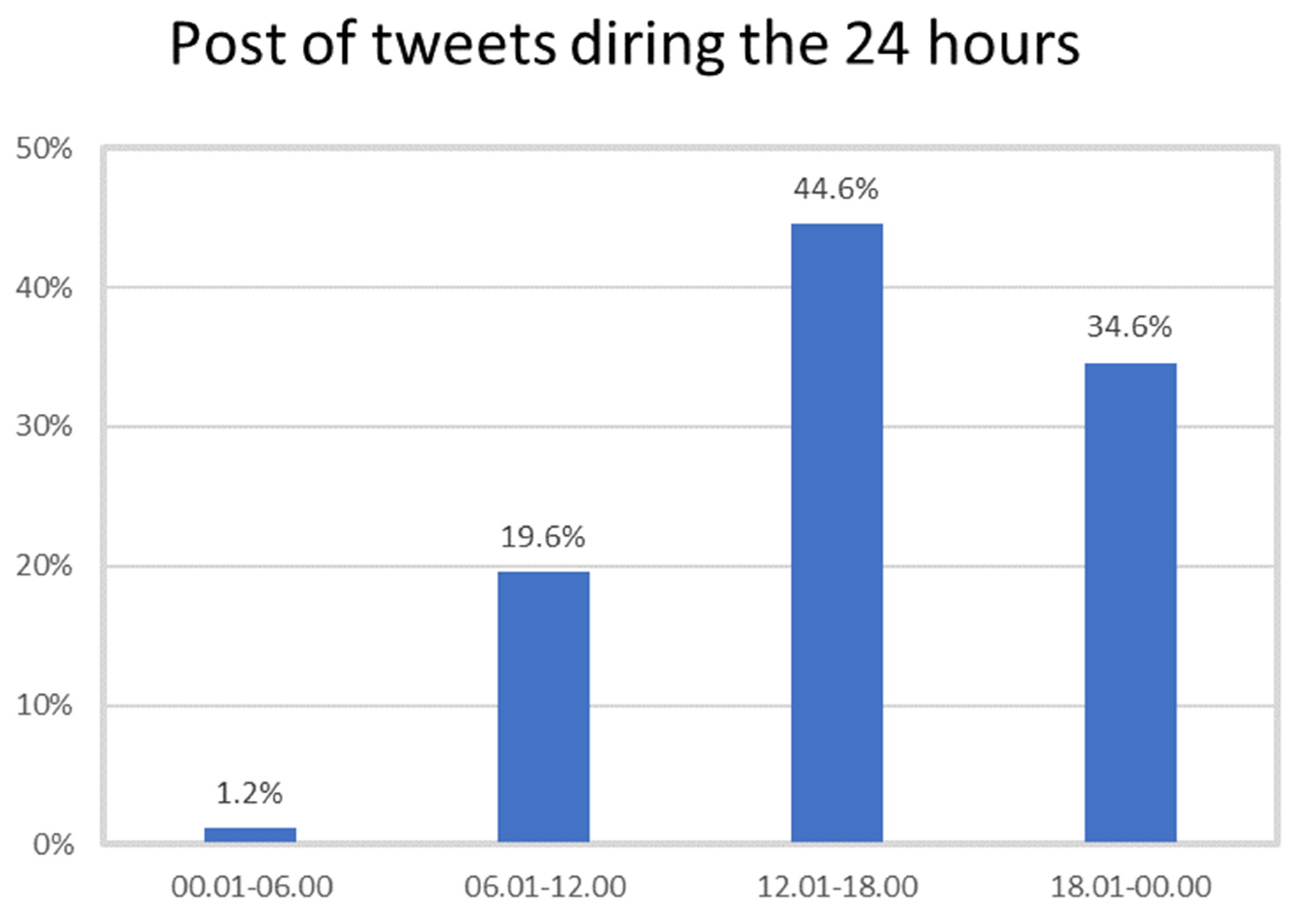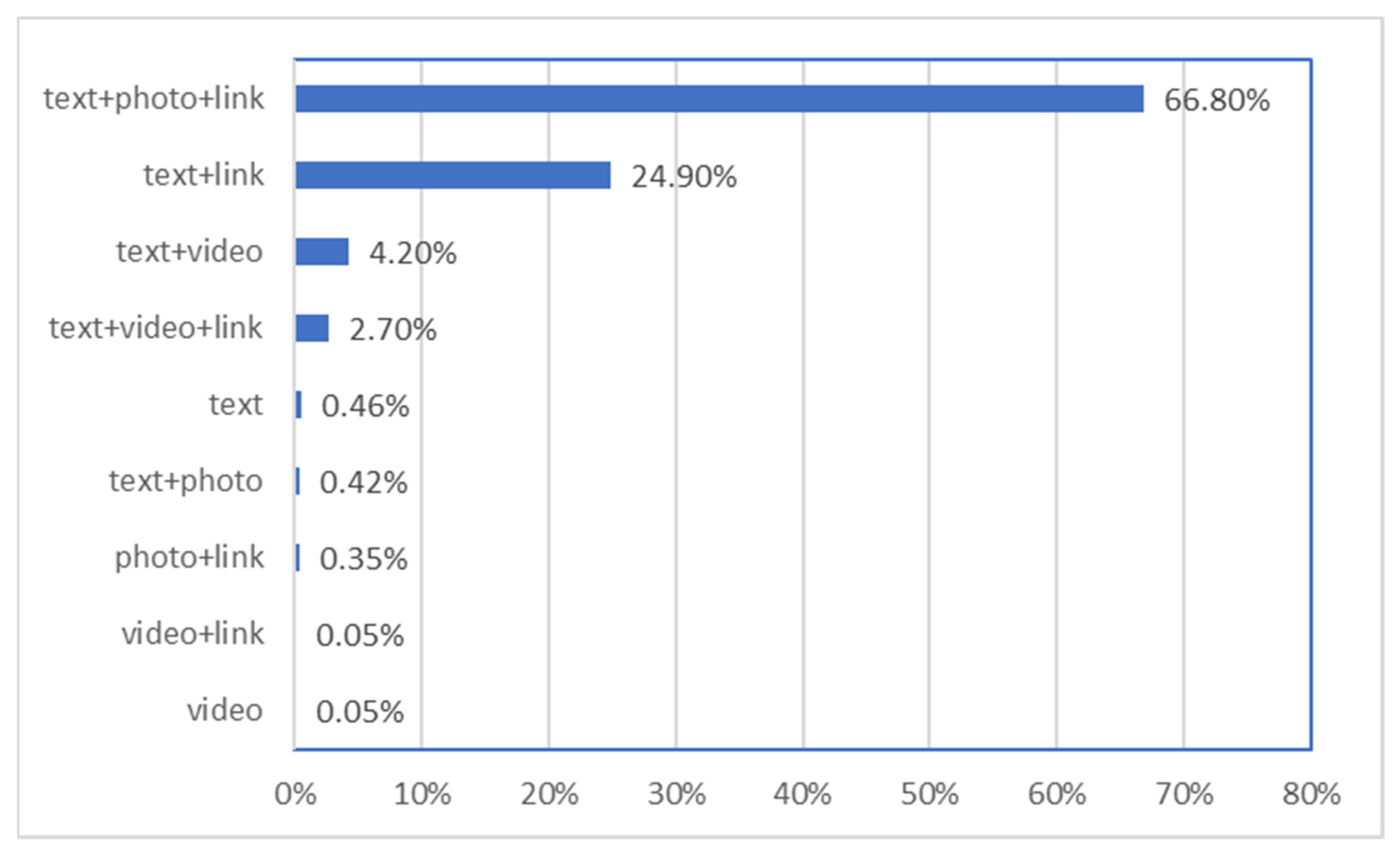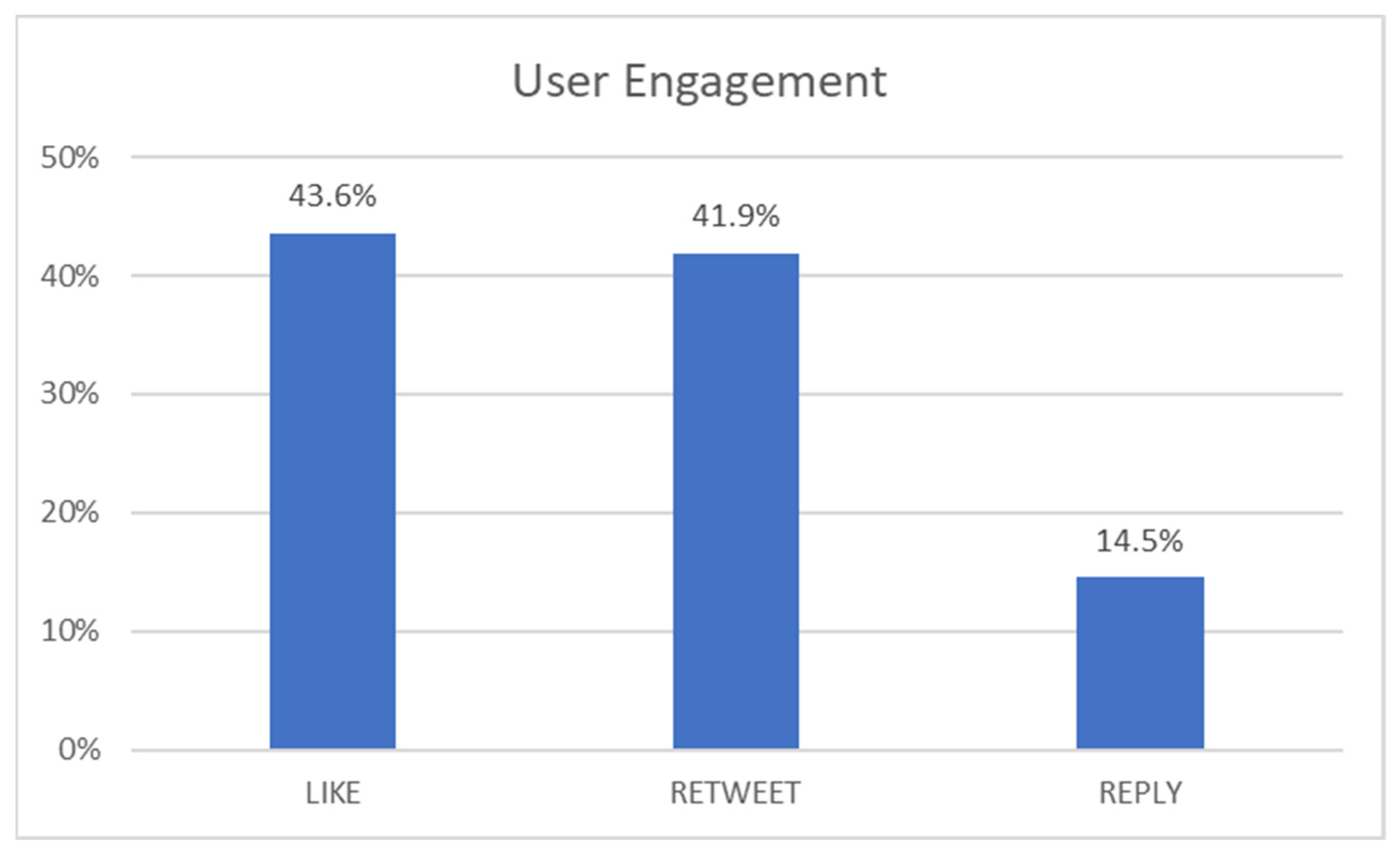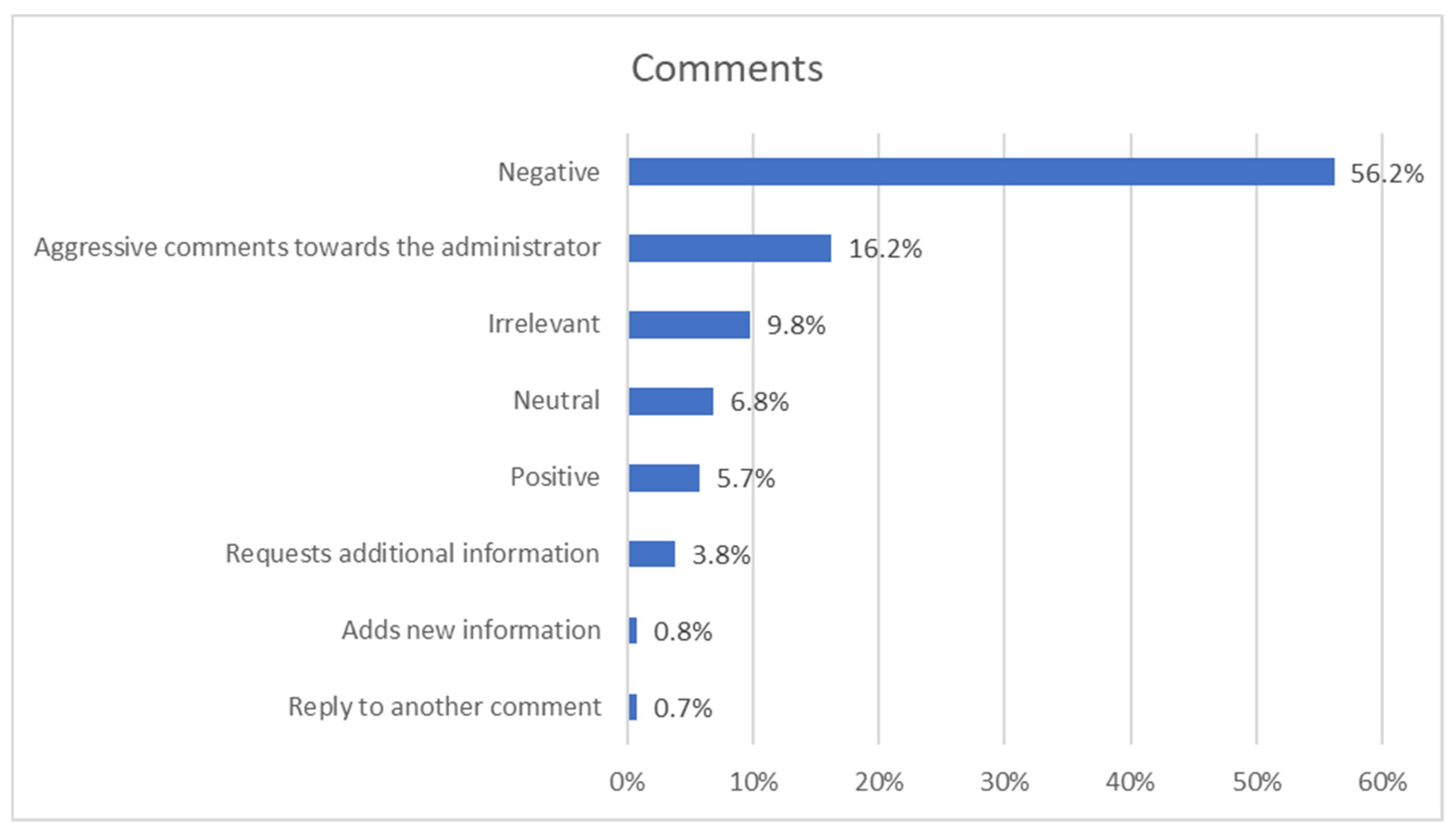Twitter Engagement in Media Organizations: The Case of the Greek National Broadcasting Corporation
Abstract
:1. Introduction
2. Literature Review
- RQ1. Do post time and post type affect the public engagement of Twitter posts?
- RQ1a. How is the impact of post time reflected in the public response to tweets?
- RQ1b. How is the impact of post type reflected in the public response to tweets?
- RQ2. What are the features of the tweets that cause a higher level of engagement?
- RQ3: Are there public comments on Twitter posts?
- RQ4: What is the users’ tone towards the tweets?
3. Data Collection
4. Results
4.1. General Findings
4.2. Correlations for Post Time
4.3. Correlations for Post Type
5. Discussion
6. Conclusions
Author Contributions
Funding
Informed Consent Statement
Data Availability Statement
Conflicts of Interest
References
- Aldous, Kholoud Khalil, Jisun An, and Bernard J. Jansen. 2019. View, like, Comment, Post: Analyzing User Engagement by Topic at 4 Levels across 5 Social Media Platforms for 53 News Organizations. Paper presented at the 13th International Conference on Web and Social Media, Münich, Germany, June 11–14; vol. 13, pp. 47–57. [Google Scholar]
- Almgren, Susanne M., and Tobias Olsson. 2016. Commenting, Sharing and Tweeting News: Measuring Online News Participation. Nordicom Review 37: 67–81. [Google Scholar] [CrossRef] [Green Version]
- Bane, Kaitlin C. 2019. Tweeting the Agenda: How Print and Alternative Web-Only News Organizations Use Twitter as a Source. Journalism Practice 13: 191–205. [Google Scholar] [CrossRef]
- Barnett, Steven. 2006. Public Service Broadcasting: A Manifesto for Survival in the Multimedia Age (A Case Study of the BBC’s New Charter). Amsterdam: RIPE, pp. 1–24. [Google Scholar]
- Belet, Ivo. 2010. The Future of the Dual System. Committee on Culture and Education, European Parliament. Available online: https://www.europarl.europa.eu/doceo/document/A-7-2010-0286_EN.html (accessed on 16 October 2021).
- Brevini, Benedetta. 2013. European Commission Media Policy and Its Pro-Market Inclination: The Revised 2009 Communication on State Aid to PSBs and Its Restraining Effect on PSB Online. European Journal of Communication 28: 183–97. [Google Scholar] [CrossRef] [Green Version]
- Broersma, Marcel, and Scott A. Eldridge. 2019. Journalism and Social Media: Redistribution of Power? Media and Communication 7: 193–97. [Google Scholar] [CrossRef] [Green Version]
- Bruns, Axel. 2018. Gatewatching and News Curation: Journalism, Social Media, and the Public Sphere. Digital Journalism 7: 543–44. [Google Scholar] [CrossRef]
- Cervi, Laura. 2019. Citizen Journalism and User Generated Content in Mainstream Media. New Dialogic Form of Communication, User-Engagement Technique or Free Labor Exploitation? Revista de Comunicação Dialógica 1: 120–41. [Google Scholar] [CrossRef]
- Coe, Kevin, Kate Kenski, and Stephen A. Rains. 2014. Online and Uncivil? Patterns and Determinants of Incivility in Newspaper Website Comments. Journal of Communication 64: 658–79. [Google Scholar] [CrossRef]
- Costa e Silva, Elsa, and María Jesús Díaz-González. 2021. Public Broadcasting Service under Austerity: Cross-Comparison between Portugal and Spain. International Communication Gazette 83: 347–70. [Google Scholar] [CrossRef] [Green Version]
- Cullinane, Mark. 2017. Participatory Cultures and Democratic Legitimation in Public Service Media: Ireland and the RTÉ Audience Council. Journal of Audience & Reseption Studies 14: 80–113. [Google Scholar]
- Cvijikj, Irena Pletikosava, and Florian Michahelles. 2013. Online Engagement Factors on Facebook Brand Pages. Social Network Analysis and Mining 3: 843–61. [Google Scholar] [CrossRef]
- De Blasio, Emiliana, Marianne Kneuer, Wolf J. Schünemann, and Michele Sorice. 2020. The Ongoing Transformation of the Digital Public Sphere: Basic Considerations on a Moving Target. Media and Communication 8: 1–5. [Google Scholar] [CrossRef]
- Diakopoulos, Nicholas, and Mor Naaman. 2011. Towards Quality Discourse in Online News Comments. Paper presented at the ACM 2011 Conference on Computer Supported Cooperative Work, Hangzhou, China, March 19–23. [Google Scholar]
- Dolan, Rebecca, Jodie Conduit, John Fahy, and Steve Goodman. 2016. Facebook for Wine Brands: An Analysis of Strategies for Facebook Posts and User Engagement Actions. Paper presented at the 9th Academy of Wine Business Research Conference, Adelaide, Australie, February 17–18; vol. 17. [Google Scholar]
- Dounoucos, Victoria A., Sunshine Hillygus, and Caroline Carlson. 2019. The Message and the Medium: An Experimental Evaluation of the Effects of Twitter Commentary on Campaign Messages. Journal of Information Technology and Politics 16: 66–76. [Google Scholar] [CrossRef]
- Fornacciari, Paolo, Monica Mordonini, Agostino Poggi, Laura Sani, and Michele Tomaiuolo. 2018. A Holistic System for Troll Detection on Twitter. Computers in Human Behavior 89: 258–68. [Google Scholar] [CrossRef]
- Go, Eun, and Denise Sevick Bortree. 2017. What and How to Communicate CSR? The Role of CSR Fit, Modality Interactivity, and Message Interactivity on Social Networking Sites. Journal of Promotion Management 23: 1–21. [Google Scholar] [CrossRef]
- Goldfarb, Avi, and Catherine Tucker. 2011. Implications of ‘Online Display Advertising: Targeting and Obtrusiveness’. Marketing Science 30: 413–15. [Google Scholar] [CrossRef]
- Kemp, Simon. 2021. Digital in Greece: All the Statistics You Need in 2021. Available online: https://datareportal.com/reports/digital-2021-greece (accessed on 16 October 2021).
- Khan, M. Laeeq, Muhammad Ittefaq, Yadira Ixchel Martínez Pantoja, Muhammad Mustafa Raziq, and Aqdas Malik. 2021. Public Engagement Model to Analyze Digital Diplomacy on Twitter: A Social Media Analytics Framework. International Journal of Communication 15: 1741–69. [Google Scholar]
- Ksiazek, Thomas B. 2018. Commenting on the News: Explaining the Degree and Quality of User Comments on News Websites. Journalism Studies 19: 650–73. [Google Scholar] [CrossRef]
- Ksiazek, Thomas B., Limor Peer, and Kevin Lessard. 2014. User Engagement with Online News: Conceptualizing Interactivity and Exploring the Relationship between Online News Videos and User Comments. New Media & Society 18: 502–20. [Google Scholar] [CrossRef]
- Lee, Na Yeon, Yonghwan Kim, and Jiwon Kim. 2015. Tweeting Public Affairs or Personal Affairs? Journalists’ Tweets, Interactivity, and Ideology. Journalism 17: 845–64. [Google Scholar] [CrossRef]
- Lewis, Seth C. 2015. Reciprocity as a Key Concept for Social Media and Society. Social Media+Society 1: 1–2. [Google Scholar] [CrossRef] [Green Version]
- López-Rabadán, Pablo, and Claudia Mellado. 2019. Twitter as a Space for Interaction in Political Journalism. Dynamics, Consequences and Proposal of Interactivity Scale for Social Media. Communication and Society 32: 1–16. [Google Scholar] [CrossRef]
- Malik, Momin M., and Jürgen Pfeffer. 2016. A Macroscopic Analysis of News Content in Twitter. Digital Journalism 4: 955–79. [Google Scholar] [CrossRef]
- Mariani, Marcello M., Matteo Mura, and Marco Di Felice. 2018. The Determinants of Facebook Social Engagement for National Tourism Organizations’ Facebook Pages: A Quantitative Approach. Journal of Destination Marketing and Management 8: 312–25. [Google Scholar] [CrossRef]
- Martínez-Sala, Alba-María, and Jesus Segarra-Saavedra. 2020. Engagement y Disengagement Online, Factores Clave En Las Estrategias de Comunicación Turística 2.0. In Tendencias de La Comunicación Para El Turismo. Edited by Verónica Altamirano Benítez, Miguel Túñez López and Isidro Marín Gutiérrez. Madrid: Dykinson, pp. 149–83. Available online: https://www.dykinson.com/libros/tendencias-de-la-comunicacion-para-el-turismo/9788491489030/ (accessed on 12 December 2021).
- Matosas López, Luis. 2018. Variables of Twitter’s Brand Activity. Esic Market Economic and Business Journal 49: 455–76. [Google Scholar] [CrossRef]
- Meier, Florian, David Elsweiler, and Max L. Wilson. 2014. More than Liking and Bookmarking? Towards Understanding Twitter Favouriting Behaviour. Paper presented at the 8th International Conference on Weblogs and Social Media, ICWSM 2014, Ann Arbor, MI, USA, June 1–4; pp. 346–55. [Google Scholar]
- Papathanasopoulos, Stylianos. 2017. Greece: Media landscapes. Available online: https://medialandscapes.org/country/greece/media/television (accessed on 16 October 2021).
- Parganas, Petros, Christos Anagnostopoulos, and Simon Chadwick. 2015. ‘You’ll Never Tweet Alone’: Managing Sports Brands through Social Media. Journal of Brand Management 22: 551–68. [Google Scholar] [CrossRef]
- Pilitsidou, Zacharenia, Nikolaos Tsigilis, and George Kalliris. 2019. Radio Stations and Audience Communication: Social Media Utilization and Listeners Interaction. Issues in Social Science 7: 23. [Google Scholar] [CrossRef]
- Reinhold, Olaf, and Rainer Alt. 2012. Social Customer Relationship Management: State of the Art and Leanings from Current Projects. Paper presented at the 25th Bled EConference, Bled, Slovenia, June 17–20. [Google Scholar]
- Rowe, Ian. 2014. Civility 2.0: A Comparative Analysis of Incivility in Online Political Discussion. Information, Communication & Society 4462: 1–18. [Google Scholar] [CrossRef]
- Russell, Frank Michael. 2019. Twitter and News Gatekeeping: Interactivity, Reciprocity, and Promotion in News Organizations’ Tweets. Digital Journalism 7: 80–99. [Google Scholar] [CrossRef]
- Sabate, Ferran, Jasmina Berbegal-mirabent, Antonio Cañabate, and Philipp R Lebherz. 2014. Factors Influencing Popularity of Branded Content in Facebook Fan Pages. European Management Journal 32: 1001–11. [Google Scholar] [CrossRef]
- Schlosser, Ann E., Tiffany Barnett White, and Susan M. Lloyd. 2006. Converting Web Site Visitors into Buyers: How Web Site Investment Increases Consumer Trusting Beliefs and Online Purchase Intentions. Journal of Marketing 70: 133–48. [Google Scholar] [CrossRef]
- Segado-Boj, Francisco, Jesús Díaz-Campo, Enrique Navarro-Asensio, and Lorena Remacha-González. 2020. Influence of News-Finds-Me Perception on Accuracy, Factuality and Relevance Assessment. Case Study of News Item on Climate Change. Mediterránea de Comunicación 11: 85–103. [Google Scholar] [CrossRef]
- Shahbaznezhad, Hamidreza, and Arvind Tripath. 2017. Studying the Effective Factors of User Engagement on Social Media Fan Pages. Paper presented at the Conference: WeB 2017: Workshop on e-Business 2017, Seoul, Korea, December 10; pp. 1–8. [Google Scholar]
- Shukla, Paurav. 2014. The Impact of Organizational Efforts on Consumer Concerns in an Online Context. Information and Management 51: 113–19. [Google Scholar] [CrossRef] [Green Version]
- Srinivasan, Balaji Vasan, Natarajan Anandhavelu, Ritwik Sinha, and Shriram Revankar. 2017. Optimal Time to Post for Maximum Social Engagement. U.S. Patent No. 9,607,273, March 28. [Google Scholar]
- Suárez-Gonzalo, Sara, Lluís Mas-Manchón, and Frederic Guerrero-Solé. 2019. Tay Is You. The Attribution of Responsibility in the Algorithmic Culture. Observatorio 13: 1–14. [Google Scholar] [CrossRef]
- Tandoc, Edson C. 2014. Journalism Is Twerking? How Web Analytics Is Changing the Process of Gatekeeping. New Media & Society 16: 559–75. [Google Scholar] [CrossRef]
- Tandoc, Edson C., and Tim P. Vos. 2015. The Journalist Is Marketing the News: Social Media in the Gatekeeping Process. Journalism Practice 10: 950–66. [Google Scholar] [CrossRef]
- Tankovska, Hristina. 2021. Twitter: Number of Users Worldwide 2019–2020. Statista.Com. Available online: https://www.statista.com/statistics/303681/twitter-users-worldwide/ (accessed on 16 October 2021).
- Tejedor, Santiago, Augusto Ventín, Laura Cervi, Cristina Pulido, and Fernanda Tusa. 2020. Native Media and Business Models: Comparative Study of 14 Successful Experiences in Latin America. Media and Communication 8: 146–58. [Google Scholar] [CrossRef]
- Tenenboim, Ori, and Akiba A. Cohen. 2015. What Prompts Users to Click and Comment: A Longitudinal Study of Online News. Journalism 16: 198–217. [Google Scholar] [CrossRef]
- Van Dijck, José, and Thomas Poell. 2015. Making Public Television Social? Public Service Broadcasting and the Challenges of Social Media. Television & New Media 16: 148–64. [Google Scholar] [CrossRef] [Green Version]
- Waddell, Thomas Franklin. 2018. This Tweet Brought to You by a Journalist: How Comment Gatekeeping Influences Online News Credibility. Electronic News 12: 218–34. [Google Scholar] [CrossRef]
- Wendelin, Manuel, Ines Engelmann, and Julia Neubarth. 2015. User Rankings and Journalistic News Selection: Comparing News Values and Topics. Journalism Studies 9699: 1–19. [Google Scholar] [CrossRef]
- Zhang, Leihan, Jichang Zhao, and Ke Xu. 2016. Who Creates Trends in Online Social Media: The Crowd or Opinion Leaders? Journal of Computer-Mediated Communication 21: 1–16. [Google Scholar] [CrossRef] [Green Version]
- Zudrell, Magdalena. 2016. Factors Affecting Branded Posts’ Popularity and Fan Page Engagement. Vienna: Modul Vienna University. [Google Scholar]




| Month | Week | Day | Time | |
|---|---|---|---|---|
| Like | ||||
| Correlation Coefficient | −0.50 ** | −0.047 ** | 0.006 | −0.016 |
| Sig. (2-tailed) | 0.000 | 0.000 | 0.635 | 0.170 |
| N | 7122 | 7122 | 7122 | 7122 |
| Retweet | ||||
| Correlation Coefficient | −0.041 ** | −0.033 ** | 0.022 | −0.067 ** |
| Sig. (2-tailed) | 0.001 | 0.006 | 0.066 | 0.000 |
| N | 7122 | 7122 | 7122 | 7122 |
| Reply | ||||
| Correlation Coefficient | 0.043 ** | 0.034 ** | 0.042 ** | −0.012 |
| Sig. (2-tailed) | 0.000 | 0.004 | 0.000 | 0.300 |
| N | 7122 | 7122 | 7122 | 7122 |
| Text | Photo | Video | Link | |
|---|---|---|---|---|
| Like | ||||
| Correlation Coefficient | −0.011 | −0.027 * | 0.112 ** | −0.086 ** |
| Sig. (2-tailed) | 0.364 | 0.024 | 0.000 | 0.000 |
| N | 7122 | 7122 | 7122 | 7122 |
| Retweet | ||||
| Correlation Coefficient | −0.051 ** | −0.046 ** | 0.143 ** | −0.136 ** |
| Sig. (2-tailed) | 0.000 | 0.000 | 0.000 | 0.000 |
| N | 7122 | 7122 | 7122 | 7122 |
| Reply | ||||
| Correlation Coefficient | 0.012 | −0.270 ** | −0.090 ** | −0.060 ** |
| Sig. (2-tailed) | 0.318 | 0.000 | 0.000 | 0.000 |
| N | 7122 | 7122 | 7122 | 7122 |
Publisher’s Note: MDPI stays neutral with regard to jurisdictional claims in published maps and institutional affiliations. |
© 2022 by the authors. Licensee MDPI, Basel, Switzerland. This article is an open access article distributed under the terms and conditions of the Creative Commons Attribution (CC BY) license (https://creativecommons.org/licenses/by/4.0/).
Share and Cite
Antonakopoulou, S.; Veglis, A. Twitter Engagement in Media Organizations: The Case of the Greek National Broadcasting Corporation. Journal. Media 2022, 3, 66-80. https://doi.org/10.3390/journalmedia3010006
Antonakopoulou S, Veglis A. Twitter Engagement in Media Organizations: The Case of the Greek National Broadcasting Corporation. Journalism and Media. 2022; 3(1):66-80. https://doi.org/10.3390/journalmedia3010006
Chicago/Turabian StyleAntonakopoulou, Styliani, and Andreas Veglis. 2022. "Twitter Engagement in Media Organizations: The Case of the Greek National Broadcasting Corporation" Journalism and Media 3, no. 1: 66-80. https://doi.org/10.3390/journalmedia3010006
APA StyleAntonakopoulou, S., & Veglis, A. (2022). Twitter Engagement in Media Organizations: The Case of the Greek National Broadcasting Corporation. Journalism and Media, 3(1), 66-80. https://doi.org/10.3390/journalmedia3010006







